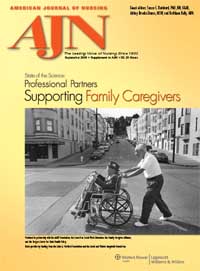 One of my dear friends, Liz, was a remarkable caregiver for her aunt Nancy, who passed away earlier this year, a few months short of her 101st birthday. I first met Nancy six years ago, when she was 95, physically active, vibrant, and independent. At the time, she had just negotiated the sale of her old car and purchase of a new one. Her health began to decline a few years later through a series of mini-strokes and a fall that broke her hip. During this period, and throughout the remainder of Nancy’s life, Liz took on the responsibility for managing the logistics and decision-making surrounding Nancy’s care, despite her full-time job as a set designer. When she came to visit, she also helped Nancy with bathing, dressing, and eating and performed many of the functions that direct-care workers provide.
One of my dear friends, Liz, was a remarkable caregiver for her aunt Nancy, who passed away earlier this year, a few months short of her 101st birthday. I first met Nancy six years ago, when she was 95, physically active, vibrant, and independent. At the time, she had just negotiated the sale of her old car and purchase of a new one. Her health began to decline a few years later through a series of mini-strokes and a fall that broke her hip. During this period, and throughout the remainder of Nancy’s life, Liz took on the responsibility for managing the logistics and decision-making surrounding Nancy’s care, despite her full-time job as a set designer. When she came to visit, she also helped Nancy with bathing, dressing, and eating and performed many of the functions that direct-care workers provide.
Liz’s commitment and devotion to Nancy was exceptional, but it was also a struggle given the amount of time involved, the seven hours she had to drive to be physically present, and the competing demands of her career. Her caregiving was further complicated by the fact that she needed to learn about the issues facing Nancy along the way and bridge the limited communication between the various parties who served as Nancy’s medical team—a monumental task for any individual. It is plainly wrong to assume that family members should coordinate care in the place of health care professionals, whose business it ought to be to coordinate among themselves and be prepared for the complex needs of older adults. As with many Americans in family caregiving situations, Liz experienced a fair amount of uncertainty, stress, and frustration.
While we believe that a better trained and better deployed professional health care workforce is the backbone of quality health care for older adults, we also believe that our health care system should be equipped to provide professional support to family caregivers. Consider the size of the problem: according to the Institute of Medicine’s 2008 report “Retooling for an Aging America,” funded in part by the John A. Hartford Foundation, more than 90% of people receiving care at home drew on the unpaid help of family and friends. Nationally, there are 43.5 million unpaid caregivers, or roughly one out of every four adults, providing care each year to a person aged 50 or older. Of those who are employed, seven in ten report making changes such as cutting back on their working hours, changing jobs, stopping work entirely, taking a leave of absence, and other financially consequential changes as a result of their caregiving role.
As many of our readers know, the demographic wave facing our nation will force our health care system to deal with complex issues, including multiple chronic illness, polypharmacy, and dementia, with an inadequate supply of health care workers. It’s estimated that by 2030 our country will need 3.5 million more of them, with some rural areas already experiencing shortages. To cope with supply imbalances, our health care system will need to integrate the family caregiver into the health care team and adopt an interdisciplinary approach wherever the elderly are.
Meanwhile, family caregivers can benefit from our project with the AARP Foundation, which will prepare social workers as well as nurses to better support the needs of family caregivers. At the core of this approach is a caregiver assessment to identify needs and referral services to match them. This approach targets common problems such as how to manage troublesome behaviors associated with dementia, how to prepare meals for people with chronic conditions like diabetes, or where to find local support groups to reduce stress. In addition, the project will also inform the development of policies that support family caregivers and raise consumer expectations around professional support.
In line with the need for a coordinated approach to develop our nation’s geriatric capacity, the Hartford Foundation helped to establish the Eldercare Workforce Alliance (EWA), a coalition of national organizations representing physicians, nurses, direct-care workers, psychologists, social workers, pharmacists, physical therapists, as well as eldercare employers, consumers, and family caregivers. Among its guiding principles is the belief that care models should have the patient and family caregivers at the center of the care team. Thanks to the EWA’s work, the Patient Protection and Affordable Care Act includes provisions for interdisciplinary geriatric education and training for specialists and non-specialists, including family caregivers and direct-care workers. (For more on the Eldercare Workforce Alliance, click here.)
While one of the most important and necessary supports for family caregivers is a better professional health care workforce, it’s also important that family members be prepared for the potentially significant role they can play. They are an ally and a resource whose contributions can be integral to high quality care.
